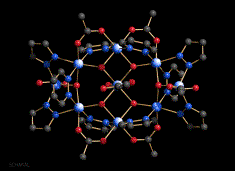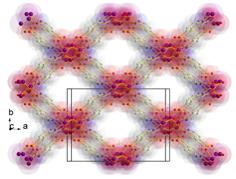
University Associate Professor

Our research is focused on the synthesis and characterisation of new materials, primarily using solvothermal synthesis. In this technique, reactions occur in solvents at temperatures above their normal boiling points by containing the reaction mixture within a pressure vessel. We have found this method to be particularly good for preparing porous materials for hydrogen storage and gas separation as well as new magnetic materials. We have an extensive range of collaborations with groups in the UK, the rest of Europe and in South Korea for performing measurements on the magnetism and porosity of our compounds.

- Magnetic materials are being prepared as part of the search for 'single molecule magnets' which represent the ultimate in magnetic data storage efficiency. We are also preparing compounds with which physicists can test theoretical models of magnetic behaviour; the same theories can be applied to other types of symmetry breaking in areas as diverse as protein folding and the early universe.
- New porous materials are much sought-after for gas storage in a future hydrogen economy. This is a very active area of research as zero-emission fuel sources are very attractive. Such materials could also be used as size- and shape-selective catalysis as well as gas separation and materials. The 'metal-organic framework' materials prepared in our lab are some of the most efficient hydrogen storage materials yet measured.
Publications
Reactions of Cp 2 M (M = Ni, V) with dilithium diamido-aryl reagents; retention and oxidation of the transition metal ions
Dalton Trans
(2013)
42
13923
(doi: 10.1039/c3dt51632f)
Magnetic properties of a family of quinternary oxalates
The European Physical Journal B
(2013)
86
248
(doi: 10.1140/epjb/e2013-30668-4)
Solvent Direction of Molecular Architectures in Group 1 Metal Pentacyanocyclopentadienides
European Journal of Inorganic Chemistry
(2012)
2013
1161
(doi: 10.1002/ejic.201201342)
Formation of Ti28 ln cages, the highest nuclearity polyoxotitanates (Ln = La, Ce).
Chemistry – A European Journal
(2012)
18
11867
(doi: 10.1002/chem.201201827)
Domain-wall spin dynamics in kagome antiferromagnets.
Physical review letters
(2011)
107
257205
Transition metal complexes of the pentacyanocyclopentadienide anion
Chemical Communications
(2011)
47
10007
(doi: 10.1039/c1cc13021h)
Assembly of the First Fullerene‐Type Metal–Organic Frameworks Using a Planar Five‐Fold Coordination Node
Angew Chem Int Ed Engl
(2011)
50
8279
(doi: 10.1002/anie.201102783)
Homoleptic 1-D iron selenolate complexes-synthesis, structure, magnetic and thermal behaviour of ∞1[Fe(SeR)2] (R = Ph, Mes)
Dalton Trans
(2011)
40
7022
(doi: 10.1039/c1dt10089k)
Two stage magnetic ordering and spin idle behavior of the coordination polymer Co3(OH)2(C4O4)2·3H2O determined using neutron diffraction.
Inorganic Chemistry
(2011)
50
2246
(doi: 10.1021/ic101897a)
A simple approach to coordination compounds of the pentacyanocyclopentadienide anion
Chemistry - A European Journal
(2010)
16
13723
(doi: 10.1002/chem.201001980)
- ‹ previous
- Page 2

